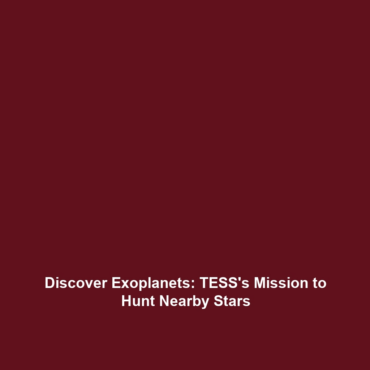<>
TESS: NASA’s Mission to Hunt for Exoplanets
Introduction
The Transiting Exoplanet Survey Satellite (TESS), launched by NASA in April 2018, represents a groundbreaking mission in the search for exoplanets, particularly those orbiting nearby stars. As part of this initiative, TESS aims to expand our understanding of the universe by discovering new worlds that potentially harbor life. Given the growing significance of exoplanets in understanding planetary formation and habitability, TESS is set to become a vital tool in this ongoing astronomical research.
Key Concepts
What is TESS?
TESS is a space telescope designed to survey large areas of the sky and detect transiting exoplanets—planets that pass in front of their host stars, causing a temporary dimming of the star’s light. This method is crucial for identifying planets that may be located in the habitable zone of their stars, where conditions might be right for life.
How TESS Fits into Exoplanet Research
TESS’s primary aim is to monitor over 200,000 stars, collecting data that will help scientists identify hundreds of new exoplanets. By focusing on bright, nearby stars, TESS facilitates follow-up observations with ground-based telescopes, thereby enhancing the capacity to study these distant worlds in detail.
Applications and Real-World Uses
The TESS mission holds numerous applications in the field of astronomy, particularly in exoplanet research. Some significant uses include:
- Identifying Potentially Habitable Exoplanets: TESS’s discoveries can lead to identifying planets within habitable zones, increasing the prospects of finding life beyond Earth.
- Characterizing Exoplanet Atmospheres: Through follow-up observations, scientists can study the atmospheric compositions of TESS-discovered planets, enhancing our understanding of their potential for habitability.
- Engaging the Public: The mission also serves to fuel public interest in astronomy, encouraging educational outreach and increased awareness regarding space exploration.
Current Challenges
Despite its success, the TESS mission faces several challenges:
- Data Management: The vast amount of data collected poses challenges in processing and analyzing exoplanet candidates efficiently.
- Follow-up Observations: Coordinating ground-based telescopes for follow-up studies can be complicated due to scheduling and resource limitations.
- False Positives: Distinguishing between true exoplanet signals and false positives (other astronomical phenomena) remains a critical issue in exoplanet detection.
Future Research and Innovations
Looking ahead, TESS is expected to drive significant advancements in exoplanet research:
- Next-Generation Telescopes: Future missions may leverage TESS’s findings to develop advanced telescopes capable of directly imaging exoplanets and analyzing their atmospheres.
- Interdisciplinary Collaboration: Increased collaboration among scientists, engineers, and educators will promote innovative approaches to exoplanet research, fostering new discoveries.
- AI and Machine Learning: Utilizing artificial intelligence to sift through TESS data could enhance the identification process of exoplanets and improve accuracy.
Conclusion
The TESS mission is a pivotal player in the quest for understanding exoplanets and their potential for harboring life. As we continue to explore the cosmos, the insights gathered by TESS will not only illuminate the nature of distant worlds but also inspire future generations to delve into the mysteries of the universe. For more information on exoplanets and upcoming astronomical missions, explore our articles on Future Exploration and Exoplanet Discovery.
This -structured article encompasses key elements about TESS, ensuring clarity, engagement, and SEO optimization through the appropriate use of keywords while adhering to journalistic standards.

Leave a Reply